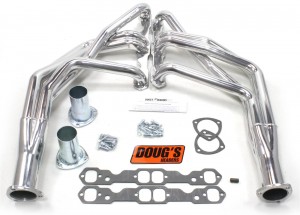Way back in the dawn of hot rodding, exhaust headers were a make-your-own proposition.
Through trial and error, you cut and welded pieces of tubing together to create headers for your Flathead Ford, Red Ram Hemi, Jimmy six, or that newfangled small block Chevy. Sometimes you got something that worked, and sometimes you didn’t.
Times have changed, and there are lots of companies bending lots of pipe. One of the better ones is Doug’s Headers. The company makes headers for classic muscle cars, trucks, SUVs, and street rods.
Performance by Design

Here is a brief description of the header configurations used by Doug’s Headers:
• Four-Tube Full Length: This is the header most people are familiar with. It uses four equal-length tubes that merge into a common header collector. The design promotes more efficient cylinder scavenging at higher rpm, which makes it ideal for racing and street cars with engines biased to high-rpm power production. The biggest issue with a four-tube header is space—four equal tubes often have clearance problems in tight engine compartments.
• Four-Tube Shorty: This header is similar to four-tube full-length headers (one primary tube per cylinder, all tubes equal length), but is shorter in overall length to provide additional ground clearance. A variation of this header is designed as a direct replacement for factory exhaust manifolds. It has an OEM-style collector in the factory location for easy connection to stock exhaust systems.
• Four-Tube Tight Tuck: This header is also known as a block hugger. It has very short primary tubes that merge into a central collector that exits straight down. Tight tuck headers are ideal for street rods with narrow frame rails and for V8 conversions in vehicles with tight engine compartments.
• Tri-Y: This is the granddaddy of modern tubular headers. Designed to maximize low and midrange torque, the tri-Y pairs cylinders together by firing order (each pair fires approximately 180 degrees of crank rotation from the other). Each pair merges into a primary tube; the two primaries then merge into a single collector. The idea is that the exhaust pulses exit the cylinder head “in order.” That frees up power otherwise used to push out “disorganized” exhaust gasses.
Built to Last
Want a quick way to identify a well-made header? Look at the header flanges. Flanges that are made from thinner gauge steel or have poorly finished cylinder head mating surfaces and welds cannot withstand the heat and stress of high performance or truck engines. The result is a header that will eventually have warped flanges and cracked primary tubes—and big exhaust leaks.
Doug’s builds its headers with 3/8-inch, 1/2- inch, or 5/8-inch flanges, depending on the application—more than adequate to resist warping and cracking from heat. Additionally, Doug’s uses heavier gauge tubing (16 gauge for cars and street rods, 14 gauge for trucks and motor homes) than many other header manufacturers. All Doug’s headers are fixture-welded in jigs to eliminate heat distortion and prevent the tubes from moving around.
Two other features set a Doug’s header apart from the pack. The first is the metallic-ceramic thermal barrier finish. An extra-cost option from other header manufacturers (if they offer it at all), it is the standard finish on every Doug’s header. The metallic-ceramic coating extends the life of a header by forming a thermal barrier on the tubing, significantly reducing under-hood temperatures and metal fatigue due to radiating exhaust heat. The coating is polished to a high luster, which not only looks good and requires minimal maintenance, but also produces a finish that is 60 percent more corrosion-resistant than ordinary header paint.
The other feature is the header gasket set. Made from an extra-thick material, the gaskets are rated up to 1,100 degrees F and 3,700 psi of pressure—about as blowout-proof as a header gasket can get. The gaskets are also port-matched to their respective headers. In fact, Doug’s does not recommend using any other gasket with its headers.
Sounds like a set of Doug’s pipes would be a great addition to your muscle car or truck, doesn’t it? The combination of uncompromised design and tuning, high-quality materials, and standard features others charge extra for is certainly hard to resist.
Check out Summit Racing’s selection of Doug’s Headers header sets!

Doug’s headers are the best. I have a set of tri-y headers on my 440 Dodge van. They work great!